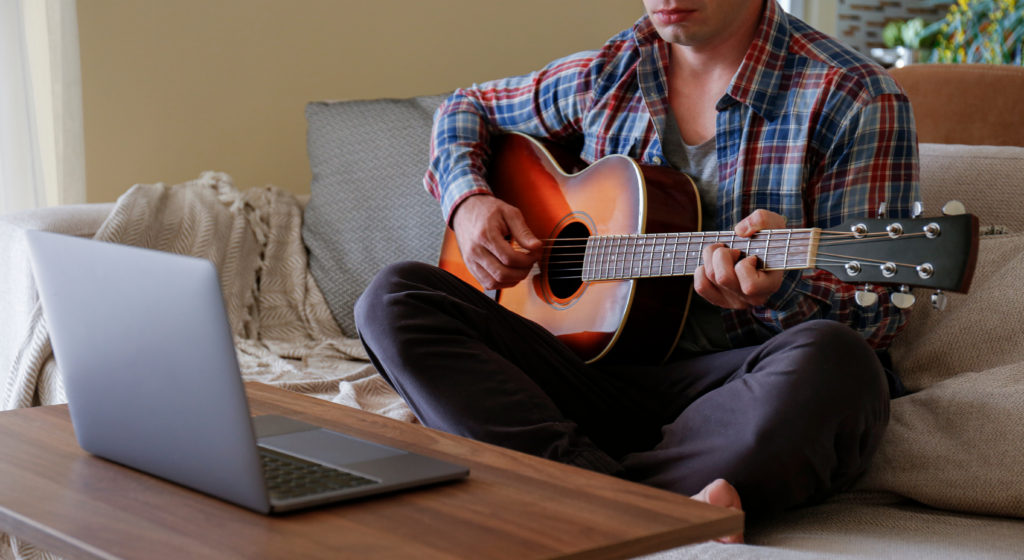There are a lot of choices that a guitarist is confronted with when they first begin learning the guitar. What type of guitar do I want to play, what guitar should I buy, and how am I going to learn to play? One such question that many beginner guitarists are confronted with is whether they should learn fingerstyle or start with a pick. Any beginner can forego the pick and learn fingerstyle first. That being said, it is more difficult to learn fingerstyle first because you will need to pick individual strings with your right hand while you train your left hand.
Now you know that learning fingerstyle as a beginner is possible even if it is more difficult. Keep reading to learn the reasons why fingerstyle is more difficult for a beginner, why you should learn fingerstyle eventually, and some tips on learning fingerstyle.
What is the Difference between Flatpicking and Fingerstyle?
This might seem obvious but you might not be aware of what the actual difference is between flatpicking and fingerstyle. Flatpicking essentially requires the guitarist to use a pick to strum the guitar strings. Picks vary pretty substantially in size, shape, and material but they all do the same thing. You will typically see a guitarist holding a pick in their right hand while playing the guitar.
Fingerstyle on the otherhand involves using your right hand to pluck the strings with your fingers. Since you have the use of all of your fingers, you will have more techniques available to you as you develop in fingerstyle versus flatpicking.
The two styles also have distinctively different sounds, think classic country, folk music, and blues for fingerstyle. Flatpicking offers a more consistent sound than fingerstyle. You can produce different sounds in fingerstyle depending on what part of your finger you hit the strings with. This gives fingerstyle a greater range in different sounds that the guitarist can produce but sometimes at the cost of consistency.
Why Fingerstyle is More Difficult to Learn
Learning to fingerstyle is an extremely rewarding endeavor and I would recommend it to anyone who plays the guitar. But learning to fingerstyle as a beginner will add additional challenges to your development as a guitarist.
Because of the fact that when beginners attempt to learn fingerstyle they are faced with learning the chords with their left hand and plucking with their right, I would recommend that you learn how to play with a pick first. Luckily, this does not mean that you need to become an expert in flatpicking before you can make a crossover into fingerstyle.
When Should You Learn Fingerstyle?
So we have established that learning fingerstyle straight out of the gate is not the best idea as a new beginner but if starting out with fingerstyle is not the best idea when should you learn it?
My recommendation is that you develop the basics with your left hand first before you move onto fingerstyle. This way you will reduce the initial complexity and you can focus on what is really important for a raw beginner and that is learning your chords. Once you have developed some knowledge of the basics (this will take approximately three months of consistent play) then you can begin working with fingerstyle.
Approaching fingerstyle in this fashion is certainly not a requirement, some people learn fingerstyle later in their guitaring development and some people start right out of the gate with fingerstyle, but it is a solid option to help improve faster with less frustration.
How Long Does it Take to Learn Fingerstyle?

Given the additional difficulty associated with fingerstyle you might be wondering how long it would potentially take to learn this skill. If you want to play songs like Jerry Reed or Tommy Emmanuel you will have to dedicate years to practice and lessons. Most of us are not trying to become that proficient though, we play fingerstyle as a hobby. It will take several months of consistent practice with fingerstyle to develop some basic competency in technique and finger independence. Aim to be able to play a few fingerstyle songs by the six-month mark and from there the sky is the limit!
Is Fingerstyle Even Worth Learning?
If you have gotten this far into the article and been dismayed about the difficulty of fingerstyle, you might be wondering if fingerstyle is even something worth learning. Fingerstyle is absolutely worth learning, it will give you a greater appreciation for the range of sound that you can create and it will open up a lot of songs that simply can’t be played with a pick.
If you enjoy some folk, classic country, or blues music, you will likely want to learn how to play fingerstyle, as a considerable amount of these genres are played with fingerstyle. Some of my favorite musicians, Jerry Reed, for example, are outstanding fingerstyle guitarists.
Tips to Help You Learn Fingerstyle
There are tons of online resources for anyone looking to learn fingerstyle. Some of them are free and some are paid. Here are a few that I have found to be really useful:
1) Guitarpro
- Guitarpro is a great resource for any guitarist, beginner-advanced. The program has thousands of songs and it allows you to download the transcriptions of music so you can learn the tabs and play along. It is easy to use and has a lot of great features that you will appreciate as you develop your skill in fingerstyle.
- Acoustic Life is a popular YouTube channel with a solid amount of content for learning fingerstyle. Tony is a great teacher and the videos on fingerstyle are extremely useful. In addition, Tony also has a lot of videos on learning chords and developing rhythm which are helpful for any beginner regardless of whether you are learning fingerstyle or flatpicking.
3) Marty Music
- Marty Music is another great YouTube channel with some excellent content for aspiring fingerstyle players. His channel features a few beginner tutorials and some videos on fingerstyle songs such as “Landslide”.
Conclusion
Fingerstyle is a rewarding and interesting technique to learn for any aspiring hobbyist. Although learning fingerstyle as a beginner is possible, I would recommend waiting until you have a few months of consistent practice under your belt so when you are ready to learn fingerstyle you can focus on your right hand.
